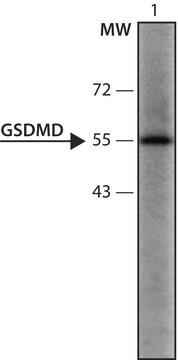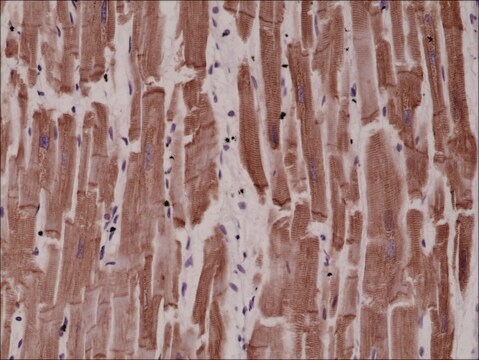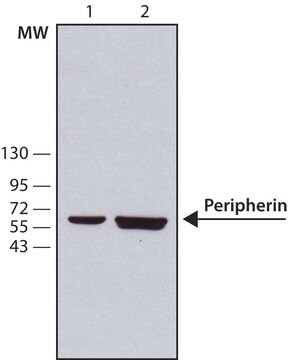C1862
Anti-Coilin antibody, Mouse monoclonal
~1.5 mg/mL, clone pδ, purified from hybridoma cell culture
Sign Into View Organizational & Contract Pricing
All Photos(3)
About This Item
Recommended Products
biological source
mouse
conjugate
unconjugated
antibody form
purified from hybridoma cell culture
antibody product type
primary antibodies
clone
pδ, monoclonal
form
buffered aqueous solution
mol wt
antigen ~80 kDa by SDS-PAGE
species reactivity
human
concentration
~1.5 mg/mL
technique(s)
immunocytochemistry: suitable
microarray: suitable
western blot: 1-2 μg/mL using HeLa nuclear extract
isotype
IgG1
UniProt accession no.
shipped in
dry ice
storage temp.
−20°C
target post-translational modification
unmodified
Gene Information
human ... COIL(8161)
General description
Monoclonal Anti-Coilin (mouse IgG1 isotype) is derived from the pδ hybridoma produced by the fusion of mouse myeloma cells and splenocytes from mice immunized with coilin. Coilin contains two nuclear localization sequences (NLS) (at amino acid 107-112 and 181-198) and several serine residues that are phosphorylated in vivo. The description of specific intranuclear structures known today as Cajal bodies was first published in 1903 by the neuro-cytologist Ramon-γ-Cajal who discovered that neurons contained spherical structures of around 0.5 μm in diameter that were often associated with nucleoli, nucleolar accessory bodies. It was found that patients with auto-antibodies against coiled bodies recognize a protein of 80 kDa termed p80-coilin. Nuclear antigens shown to colocalize with p80 coilin in Cajal bodies include basal transcription factors, cell cycle factors (cdks), splicing snRNPs and nucleolar factors including snoRNP.
Specificity
The antibody recognizes the C-terminal region of human coilin and does not recognize mouse coilin.
Immunogen
C-terminal (389 amino acids) human coilin
Application
Monoclonal Anti-Coilin antibody produced in mouse has been used in:
- immunoblotting
- immunocytochemistry
- cell microinjection
- fluorescence imaging
- indirect immunofluorescence
Biochem/physiol Actions
Mutating Serine-202 to Aspartate causes the disappearance of coiled bodies and a redistribution of coilin to intranucleolar domains. Coilin plays a key role in ribonucleoprotein and Cajal body formation.
Physical form
Supplied as a solution in 0.01 M phosphate buffered saline, pH 7.4, and 15 mM sodium azide.
Disclaimer
Unless otherwise stated in our catalog or other company documentation accompanying the product(s), our products are intended for research use only and are not to be used for any other purpose, which includes but is not limited to, unauthorized commercial uses, in vitro diagnostic uses, ex vivo or in vivo therapeutic uses or any type of consumption or application to humans or animals.
Not finding the right product?
Try our Product Selector Tool.
Storage Class Code
12 - Non Combustible Liquids
WGK
nwg
Flash Point(F)
Not applicable
Flash Point(C)
Not applicable
Choose from one of the most recent versions:
Already Own This Product?
Find documentation for the products that you have recently purchased in the Document Library.
Cajal bodies and coilin?moving towards function
Ogg SC and Lamond AI
The Journal of cell biology, 159(1), 17-21 (2002)
F Almeida et al.
The Journal of cell biology, 142(4), 899-912 (1998-08-29)
The coiled body is a distinct subnuclear domain enriched in small nuclear ribonucleoprotein particles (snRNPs) involved in processing of pre-mRNA. Although the function of the coiled body is still unknown, current models propose that it may have a role in
P68 RNA helicase (DDX5) alters activity of cis-and trans-acting factors of the alternative splicing of H-Ras
Camats M, et al.
Testing, 3(8), e2926-e2926 (2008)
Coilin: The first 25 years
Machyna M, et al.
RNA Biology, 12(6), 590-596 (2015)
Gall, J.G.
Annual Review of Cell Biology, 16, 273-273 (2000)
Our team of scientists has experience in all areas of research including Life Science, Material Science, Chemical Synthesis, Chromatography, Analytical and many others.
Contact Technical Service





